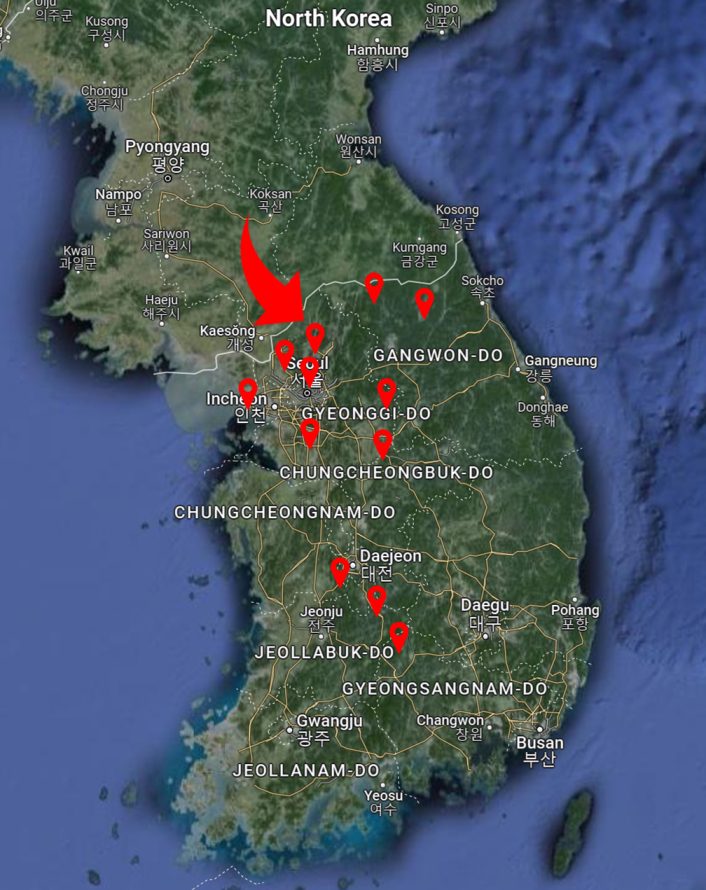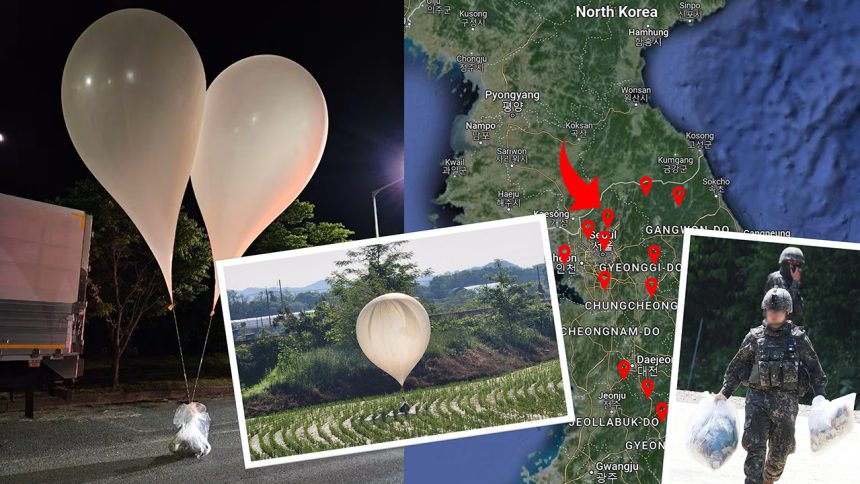Over 260 North Korean balloons filled with faeces and various waste were sent over the border all over South Korea.
In a bizarre and provocative move, North Korea sent over 260 balloons across the border to South Korea with various waste material including faeces.
On May 28, 2024, around 11pm local time, the Republic of Korean Air Force and Army radars detected balloons launched from North Korea crossing the border. Initially assumed to be propaganda leaflets, the Republic of Korea Army and Air Force decided not to shoot down the balloons during transit. While balloons with leaflets (or intelligence gathering gear….) are a common occurrence, such widespread deployment along with the usage of waste marked a new set of provocations from North Korea.
As of May 29, 2024, the South Korean Joint Chiefs of Staff have confirmed roughly 260 balloons filled with faeces, manure, electric wires, Chinese batteries, and other household waste have landed all across the Korean peninsula. The balloons were discovered in various regions spanning from the border areas near the Demilitarized Zone to Seoul, and as far as the southern provinces.

So far areas with the reported balloon landings are as follows: Muju-gun, Geochang-gun, Gyeryong-siYeongcheon-si, Chungju-si, Cheongju-si, Jecheon-si, Cheorwon-gun, Inje-gun, Hwacheon-gun, Wonju-si, Paju-si, Dongducheon-si, Pyeongtaek-si, Ganghwa-gun, and the Seoul Metropolitan area.
No, I’m not shitting you.
North Korea sent bunch of balloons filled with “feces and other waste materials” to the South.
Over 200 such balloons were discovered across South Korea as of 1300 local time, 29 May 2024 💩#psyop #korea #southkorea #northkorea pic.twitter.com/JrNZlERoCG
— Korea Defense Blog (@Korea_Defense) May 29, 2024
Photographs circulated online show various balloons in alleyways, open fields, farmlands and roads having released a variety of trash. These included pieces of paper; black soil (assumed to be sewer waste); and batteries. Some ‘packages’ were singular balloons while some were dual-balloons, possibly configured owing to the heavy ‘payload’ of the trash!
Photos are emerging this morning of the balloons sent from North Korea that have landed in South Korea overnight, filled with trash not propaganda leaflets, and some bursting their loads with what appears to be manure. Authorities say some 90 balloons have been detected. https://t.co/OzSuqlilCi pic.twitter.com/O6mOd5vqyu
— Raphael Rashid (@koryodynasty) May 29, 2024
Other photos showed the garbage bags with wires connected to an electronic control box, tied to the tether string linking to the balloons. Presumably, they were timed to ‘release’ the trash.
South Korean authorities are now going through the leaflets and trash to examine whether they had any propaganda material or specific targeted messages to its citizenry. So far, it appears that the balloons did not have any military intent but only a riposte for such material coming from the South.
Retaliation
The event is thought to be a retaliatory move from the North Korean state against both South Korean individuals sending leaflets as well as the China – Japan – South Korea trilateral summit held in Seoul.
Previously on May 26, North Korean state media had released a speech by Kim Kang-il, a senior official at North Korea’s Ministry of National Defense, threatening, “We will also respond to frequent provocations of leaflets and rubbish in the border areas.” This statement had analysts divided up as to what it was reacting to. Leaflets are a common psyop tool used by both parties on either side of the border.
Kim Kang-iI, had named a litany of complaints against the Republic of Korea (RoK). KCNA quoted him saying these included “various means of air spying by the US and puppet RoK air force openly intensifying their air espionage.” He counted “16 strategic reconnaissance planes” of the US Air Force, “five RC-135s and eleven U-2Ss involved in air espionage against the DPRK from May 13 to 24, 2024. May 20 to 23 saw the US Air Force “mobilizing three” RC-135s.
“Hostile military espionage, various military drills…psychological warfare by scattering leaflets by use of balloons and various dirty things near border areas of the DPRK, increasing intrusion across our maritime border” with “navy warships and maritime police,” were some of the violations that Pyongyang alleged.
Kang-iI then touched upon balloons released by South Korea. “We have already clarified our stand on the dangerous farce of scattering things by balloons. Tit-for-tat action will be taken against frequent scattering of leaflets and other rubbish by the ROK near border areas. Mounds of wastepaper and filth will soon be scattered over the border areas and the interior of the ROK and it will directly experience how much effort is required to remove them.”
The balloons are often released by North Korean defectors who cross into the South in a bid to galvanize the population against the one-party dictatorship. But the North often sees a military goal behind the act. “Scattering leaflets by use of balloons is a dangerous provocation that can be utilized for a specific military purpose,” Kang II added. Presumably, Pyongyang believes that these leaflets might be used to warn residents to quickly relocate before a military attack, or possibly foment internal dissent.
While the South Korean government does not officially condone such activities, private entities regularly send balloons to North Korea filled with leaflets, western media, and humanitarian aid. North Korean balloons, on the other hand are mostly state run and filled with leaflets.
A private South Korean right-wing entity has claimed to have sent 20 balloons containing leaflets and K-pop videos in flash drives up north on May 10, 2024. Some argue that North Korea’s leaflets sent were a direct response against this. While it does seem plausible, the response time was much longer and drastic than usual and begs further explanation. Instead, others suspect that the move was to protest ahead of the China – Japan – South Korea trilateral summit that was held between May 26 and 27 in Seoul.
Civilians question the potential use of biochemical weapons in the future.
While the incident is widely being deemed as a hilarious, attention-grabbing provocation from North Korea, some civilians have questioned the possibility of future ‘attacks’ with more harmful payloads.
The incident has raised concerns amongst people about potential future threats, that such balloons could be utilized to carry explosives or biological agents, posing a grave danger to public safety. It should be noted that defence analysts believe that the use of balloons as a means of delivering such payloads is highly unlikely, but some improvements to the current action plan could be made for the off chance that it does become a reality. While the immediate impact of the faecal balloon provocation is primarily psychological, the possibility of future escalations cannot be ignored.
In response to the incident, the South Korean government has vowed to remain vigilant and handle the situation with caution, refraining from any actions that could further escalate tensions on the Korean Peninsula. Efforts are underway to investigate the source of the balloons and prevent similar provocations in the future.
The faecal balloon provocation serves as a stark reminder of the enduring tensions between North and South Korea, highlighting the complex dynamics at play on the Korean Peninsula. While on surface a mere hilarious provocation, this can be seen as North Korea’s struggle to remain relevant in the global political landscape or perhaps heightened tensions with its southern neighbours amidst a 74-year long conflict.









